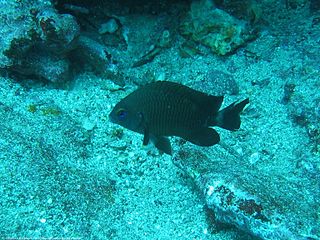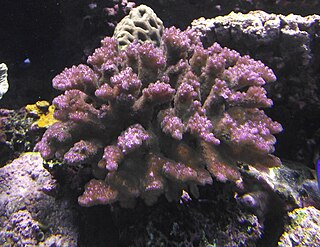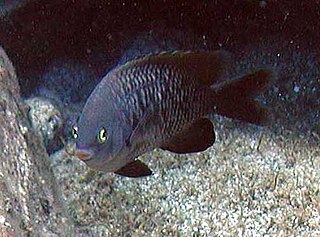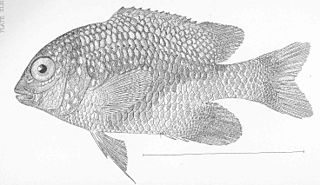
Pomacentridae is a family of ray-finned fish, comprising the damselfishes and clownfishes. This family were formerly placed in the order Perciformes but are now regarded as being incertae sedis in the subseries Ovalentaria in the clade Percomorpha. They are primarily marine, while a few species inhabit freshwater and brackish environments. They are noted for their hardy constitutions and territoriality. Many are brightly colored, so they are popular in aquaria.

Stegastes is a genus of ray-finned fish in the family Pomacentridae. Members of this genus are marine coastal fishes except for S. otophorus, which also occurs in brackish water. These fish are known by the names of damselfish, gregory and major. They are small tropical fish associated with coral and rocky reefs in the Atlantic, Indian and Pacific Oceans. They are sometimes found in the aquarium trade where they are an easy-to-keep fish, but they do not mix well with other fish of their own or other species because of their territorial habits and aggressiveness.

Stegastes nigricans, the dusky farmerfish, is a species of damselfish found around coral reefs at a depth of one to 12 meters, in tropical climates between 30°S and 30°N. They are known for farming monocultures of algae such as cyanophores and rhodophytes.
Pocillopora inflata is a species of stony coral in the family Pocilloporidae. It was first described by Peter William Glynn in 1999. It is found growing on coral reefs in the tropical eastern Pacific Ocean but is nowhere abundant.

Stegastes fuscus, the dusky damselfish, is a species of bony fish in the family Pomacentridae found near the seabed in shallow waters on the western fringes of the Atlantic Ocean.

The giant damselfish inhabit rocky reefs, below the surf zone at depths of 1–25 m. They feed mainly on low-profile, attached algae. They defend both feeding and reproductive territories by driving off other fishes and divers who come too close. They are oviparous, and form distinct pairings during breeding. The eggs are demersal and adhere to the substrate. Males guard and aerate the eggs.

Stegastes beebei, is a species of damselfish found on coral and rocky reefs at depths between 0 and 15 m. They are somewhat territorial, and chase away small intruders. They are omnivorous, grazing on algae and nibbling at small crustaceans and the tentacles of anemones. They are oviparous, with distinct pairing during breeding. The eggs are demersal and adhere to the substrate. Males guard and aerate the eggs.

Pocillopora verrucosa, commonly known as cauliflower coral, rasp coral, or knob-horned coral, is a species of stony coral in the family Pocilloporidae. It is native to tropical and subtropical parts of the Indian and Pacific Oceans.

Stegastes fasciolatus, commonly called the Pacific gregory, is a damselfish of the family Pomacentridae. It is native to the tropical western Indo-Pacific. It feeds on filamentous algae.

Stegastes imbricatus, commonly called the Cape Verde gregory, is a damselfish of the family Pomacentridae. It is native to the tropical eastern Atlantic Ocean.

Stegastes leucorus, commonly known as the whitetail damselfish, the whitetail gregory or the whitetail major, is a damselfish of the family Pomacentridae. It is native to the tropical eastern Pacific Ocean.

Stegastes apicalis, commonly known as the Japanese gregory, is a damselfish of the family Pomacentridae.

Stegastes arcifrons, the island major or Galapagos gregory, is a damselfish of the family Pomacentridae native to the eastern Pacific Ocean. Its range extendins from Costa Rica to the Cocos Islands, Malpelo Island, and the Galapagos Islands. It is found on rocky and coral reefs at depths ranging from 1 to 20 m. It is common in many parts of its range, and its population appears to be stable. No particular threats have been identified, and the IUCN rates it as being of "Least Concern".

Stegastes aureus, the golden gregory, is a damselfish of the family Pomacentridae native to islands in the tropical Pacific Ocean, its range including New Caledonia, the Gilbert Islands, Line Island, Phoenix Island, Samoa, the Tuamotu Archipelago, and the Marquesas Islands. It is found on coral reefs at depths ranging from 1 to 5 m.

Stegastes rectifraenum, commonly known as the Cortez damselfish or Cortez gregory, is a damselfish of the family Pomacentridae. It is native to the tropical eastern Pacific Ocean, its range including Baja California in Mexico, and the Gulf of California. It is found on rocky inshore reefs at depths ranging from 1 to 10 m.

Stegastes flavilatus, commonly known as beaubrummel, is a damselfish of the family Pomacentridae. It is native to the tropical eastern Pacific Ocean, its range extends from Mexico, Baja California and the Gulf of California southwards to the Galapagos Islands and mainland Ecuador. It is found on rocky inshore reefs at depths ranging from 1 to 10 m.

Stegastes punctatus, commonly known as the blunt snout gregory, is a damselfish of the family Pomacentridae. It is native to the Indo-Pacific region where it is found at depths down to 5 m (16 ft). Its range extends from the East African coast and the Red Sea to the Line Islands, the Society Islands, the Ryukyu Islands, the Bonin Islands, New Caledonia, Tonga and Micronesia. It is a very territorial species and drives other fish away from its "garden" of filamentous algae.

Stegastes redemptus, commonly known as the clarion major, clarion damselfish or clarion gregory, is a damselfish of the family Pomacentridae. It is native to the tropical eastern Pacific Ocean, its range extending from the Revillagigedo Islands to the coast of Baja California. It is found on rocky reefs at depths ranging from 1 to 15 m.

Abudefduf troschelii, the Pacific sergeant major or Panama sergeant major, is a species of damselfish belonging to the family Pomacentridae that can be identified by the pronounced black stripes on the lateral sides of the fish. Its specific name honors the zoologist Franz Hermann Troschel (1810-1882). It is native to the neritic pelagic zone of the shallow water coral reefs in the Eastern Pacific Ocean and they are an omnivorous species feeding on plankton and algae attached to their coral habitat. Abudefduf troschelii is a sister-species of A. saxatilis but have diverged from each other since the uplift of the isthmus of Panama, separated by the rise of the Panama land bridge 3.1 to 3.5 million years ago. Males, like in many other marine species, take care of and defend newborn A. troschelii after they have been hatched by eggs from the female. There are currently no major threats to the species and there is no indication of a current decline in its population size. The IUCN Red List lists this damselfish as being of “least concern”.

Microspathodon bairdii, the bumphead damselfish, is a species of ray-finned fish from the family Pomacentridae. It is found in the eastern Pacific Ocean.



















